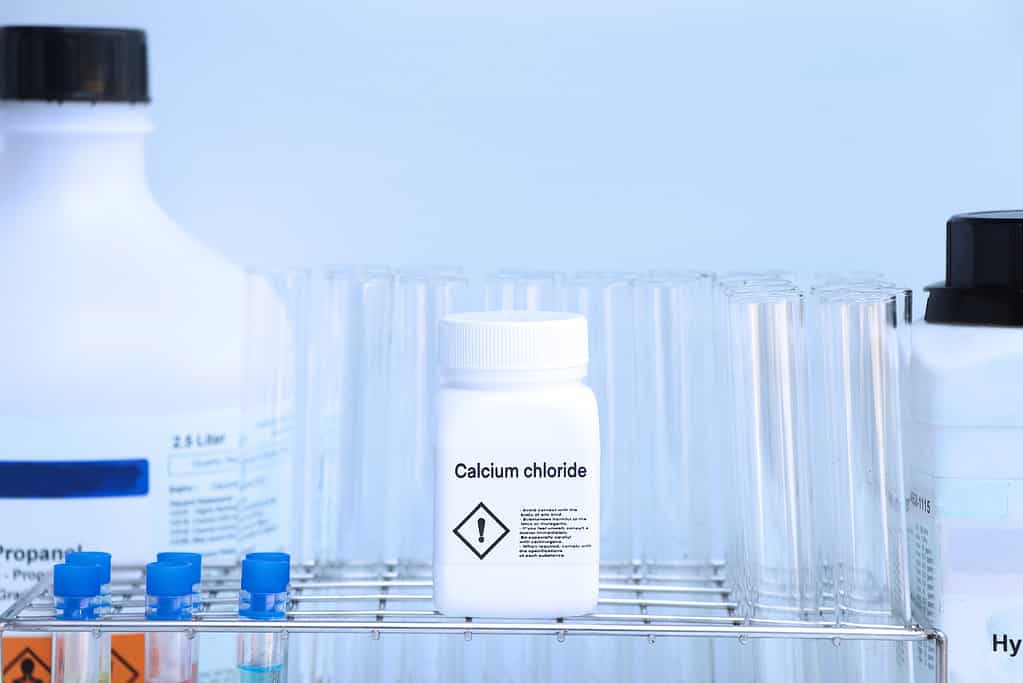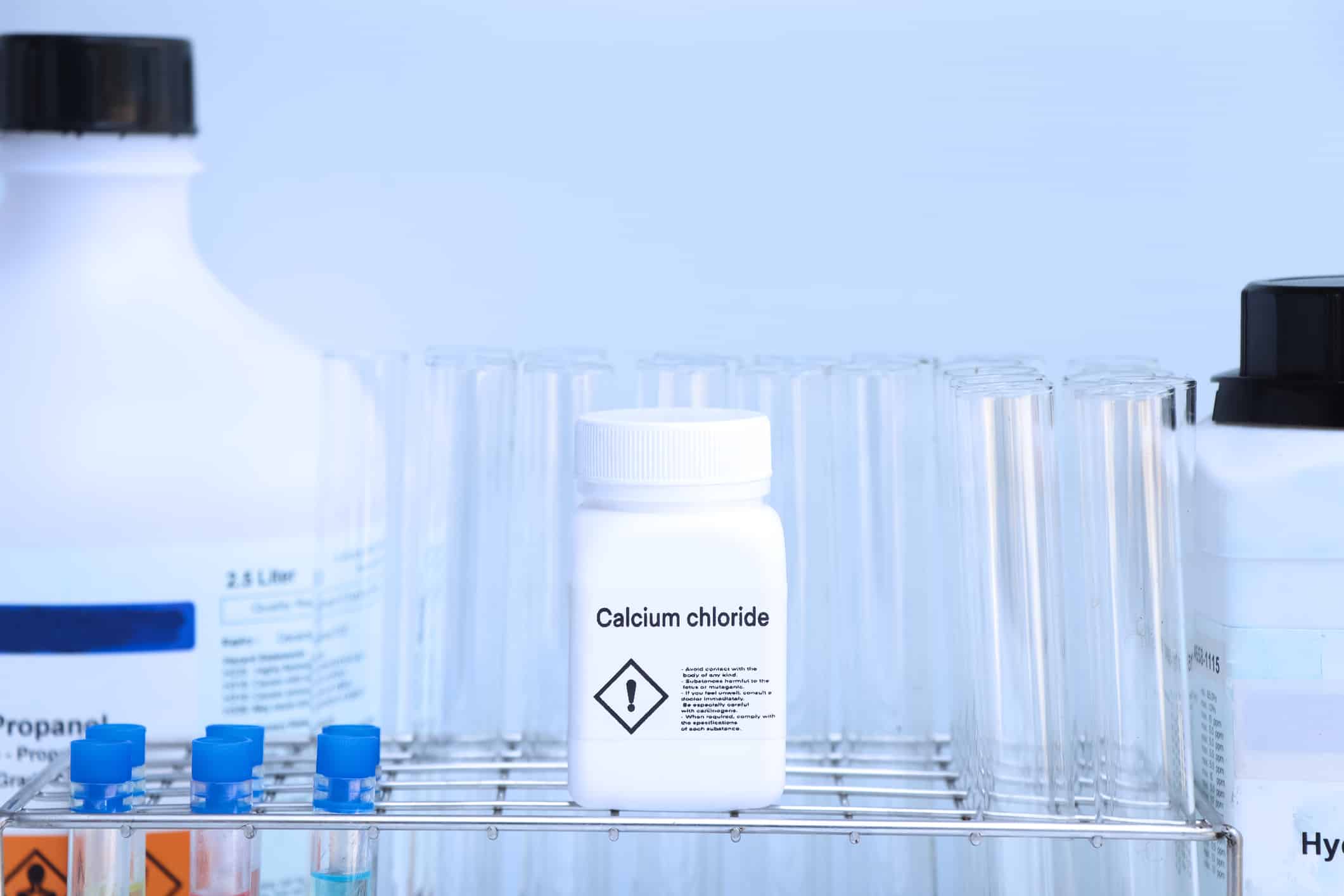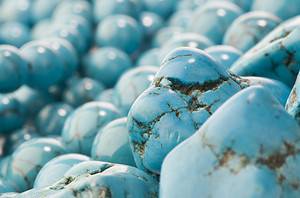Calcium chloride makes the world go around. Well, not exactly, but it does keep things moving when roads get especially icy and slick. We use calcium chloride, CaCl2, in massive quantities to treat roads and highways, especially in North America. It works better than rock salt, for reasons that will be explained a little later. We use calcium chloride for a whole lot of other purposes, too. In this article, we will discover the molar mass of calcium chloride, take a look at its structure, and learn about why it is such an effective chemical compound.

Calcium chloride, CaCl
2, has a multitude of uses inside the lab and out.
©Kittisak Kaewchalun/ via Getty Images
The Molar Mass of Calcium Chloride
Every pure substance, which includes every element on the periodic table and every defined chemical compound, has a specific molar mass. This molar mass influences the physical and chemical properties of the substance. But what exactly does molar mass mean?
The molar mass of a substance is simply the mass of one mole of that substance expressed in grams. The molar mass of calcium chloride equals 110.98 grams per mole. In chemistry, a carefully defined number of particles, whether atoms or molecules, makes up a unit called a mole. That number, known as Avogadro’s number or Avogadro’s constant, equals approximately 6.022 × 1023 units. This constant, named for the Italian scientist, Amadeo Avogadro, is the same in every circumstance for every pure substance, and it is essential to understanding chemistry and how the world works.
Molar Mass vs. Atomic Mass
The molar mass of an element or compound derives from its atomic mass. The atomic mass of each element on the periodic table is listed, usually just below the chemical symbol. This mass is determined by averaging all the known isotopes of the element, weighted by their proportion as found in nature. Isotopes are atoms of the same element with the same number of protons and a varying number of neutrons.
Each isotope of an element has a fixed number of protons, equal to the atomic number of the element, but the number of neutrons varies. Each proton and each neutron has a value of one atomic mass unit, while the mass of any number of electrons is negligible. Let’s take carbon as an example. An isotope such as carbon-12, with six protons and six neutrons, has a total atomic mass of 12. Meanwhile, carbon-14, a radioactive carbon isotope used in dating organic materials, has six protons and eight neutrons. Carbon-12 is by far the most common carbon isotope; therefore, the atomic mass of carbon is measured at 12.011 atomic mass units.
Calculating the Molar Mass of Calcium Chloride
Knowing the atomic mass of an element, it is easy to convert to the molar mass. Simply express the atomic mass in grams, and you have the mass of one mole of atoms of that element. For a compound, which contains two or more atoms of the same or different elements in each molecule, you must complete an additional step.
Calcium chloride, CaCl2, has three atoms in each molecule. It has one calcium atom and two chlorine atoms. One mole of calcium chloride molecules would have one mole of calcium atoms and two moles of chlorine atoms. To find the mass of one mole of calcium, simply convert the atomic mass of calcium to grams. One mole of calcium has a mass of 40.08 grams. One mole of chlorine has a mass of 35.45 grams. But there are two moles of chlorine in each mole of calcium chloride, so that amount must be doubled. Adding all of these gives a total of 110.98 grams as the molar mass of calcium chloride.
Atomic Structure of Calcium Chloride
Calcium chloride is a salt, much like sodium chloride. Many different types of salts exist. These compounds have cations, or positively charged ions, bonded ionically to anions, or negatively charged ions. Salts often combine positively charged ions from Group 1 of the periodic table, the alkali metals, or Group 2, the alkaline earth metals, with negatively charged non-metals, such as the Group 17 halides or polyatomic ions, such as the CO32- carbonate ion.
In chemical compounds, each atom seeks to fill its outer orbitals, or shell, with enough electrons to reach the most stable configuration that it can. This stable configuration is equal to that of the nearest noble gas, or Group 18 element. Ionic bonding involves the giving and taking of electrons, as opposed to the sharing of electrons as seen in covalent bonding. Molecules like carbon dioxide utilize covalent bonding and share electrons. In this way they reach the desired noble gas configuration with full outer electron shells. But calcium chloride and other salts use ionic bonding to reach the same desired configuration.
Calcium, a Group 2 alkaline earth metal, has just two electrons in its outer shell. The easiest way for a calcium ion, Ca2+, to reach the stable configuration of the nearest noble gas, argon, is to give away those two electrons. Chlorine, from Group 17, has seven electrons in its outer shell. The chloride ion, Cl–, is just one electron away from the nearest noble gas configuration. It can reach that configuration most easily by accepting an electron.
Calcium Chloride Bonds
Each calcium ion, with its plus two charge, can bond with two chloride ions, each with a minus one charge, to form a molecule with a neutral charge. When this happens, the calcium ion gives up both of its extra electrons, and each chloride ion accepts one of them. This gives all three ions a perfect eight electrons in their outer shells.
The calcium ion situates itself in the middle, with the chloride ions on either side in a relatively linear formation. This gives the more electronegative chloride ions as much space as possible to avoid one another. It works in much the same way that magnets repel each other when their negative sides are placed together. The ions in calcium chloride generally stay bonded in this way unless a more desirable combination presents itself. Ions are a bit fickle that way.
Calcium Chloride in Our World
Calcium chloride has a multitude of uses from the oil industry to the illegal drug trade to the processing of foods and pharmaceuticals. Manufacturers use it as an electrolyte in bottled water and sports drinks, and to correct the mineral balance in both beer and some kinds of cheese. It gives many types of pickles their salty taste without increasing their sodium content. It helps prevent food spoilage by acting as a desiccant and a preservative.

Calcium chloride is sometimes used to balance minerals when making both cheese and beer.
©wideonet/iStock via Getty Images
Doctors use it to treat various medical conditions such as hypocalcemia, and veterinarians even use it to sterilize male animals from cats to cattle. Although calcium chloride is safe in small amounts, in its solid form it can cause irritation if handled. Also, because it produces heat when it dissolves in water, it can cause burns to the mouth and throat if ingested.
As mentioned at the beginning of this article, we use calcium chloride primarily to prevent the icing of roads, particularly at very low temperatures. Calcium chloride has a freezing point much lower than sodium chloride when dissolved in water. De-icing solutions of sodium chloride, NaCl, only work at temperatures down to approximately 15 °F. However, solutions of calcium chloride, CaCl2 work at temperatures as low as -25 °F. That is a difference of 40 degrees! Not only that, at below-freezing temperatures where both solutions work, calcium chloride melts ice faster than sodium chloride. This prevents refreezing as temperatures continue to drop.

Calcium chloride works much better at de-icing in low temperatures than sodium chloride.
©Pavel Byrkin/ via Getty Images
Why Is Calcium Chloride So Effective?
Scientists explain that one reason calcium chloride is more effective and has a lower freezing point in solution than sodium chloride relates to the number of ions in each compound. Each molecule of sodium chloride, NaCl, breaks down into two ions: one sodium ion, Na+, and one chloride ion, Cl-. Each molecule of calcium chloride, however, breaks down into three ions: one calcium ion, Ca2+, and two chloride ions, Cl-. The more available ions floating in the solution, the more disruption exists where the freezing of water would occur. Also, when calcium chloride dissolves in water, it does so exothermically, giving off significant heat. One can easily see that due to these chemical properties, calcium chloride is very effective, especially in situations involving ice.
We also use concentrated calcium chloride solutions to suppress dust on dirt roads and in urban areas. It is very effective in this function because it is highly hygroscopic, meaning it has a very strong attraction to water. It can effectively draw water out of the air and out of solutions. By drawing water from the air, a calcium chloride solution can keep the surface of a dirt or gravel road just moist enough to prevent blowing dust.
How is Calcium Chloride Sourced?
In order to provide the massive quantities of calcium chloride we use, the compound must be sourced naturally or manufactured. We produce much of the calcium chloride used in North America from naturally occurring brines. These salty solutions, found within sandstone formations, must be purified as they contain multiple salts. Calcium chloride can also be produced through chemical reactions involving calcium carbonate, or limestone.
The Molar Mass of Similar Salts
Calcium chloride combines a positively charged cation with a negatively charged anion to produce an ionically bonded salt. It has a molar mass of 110.98 grams per mole. The chart below compares calcium chloride with a few similar salts. Each compound in the table combines cations from either the alkali or alkaline earth metals with anions from the halides. Anions from the Group 1 alkali metals bond with a single halide. Anions from the Group 2 alkaline earth metals bond with two halides.
| Compound Name | Chemical Formula | Molar Mass | Interesting Uses |
|---|---|---|---|
| Calcium chloride | CaCl2 | 110.98 g/mol | De-icing agent at low temps |
| Sodium chloride | NaCl | 58.44 g/mol | Food additive and healthcare |
| Magnesium fluoride | MgF2 | 62.30 g/mol | Optics, including space telescopes |
| Lithium bromide | LiBr | 86.85 g/mol | Dehumidifier in HVAC systems |
| Potassium iodide | KI | 166.00 g/mol | Protect the thyroid gland |
| Beryllium iodide | BeBr2 | 168.82 g/mol | Used in nuclear reactions |
Conclusion
Calcium chloride is a versatile chemical compound with a wide variety of uses. Populations all over the world use this amazing salt for all sorts of purposes from preserving foods to manufacturing material goods. Experts predict the demand for calcium chloride will rise over the coming years, especially in relation to road treatments, mining operations, and the oil industry. Because calcium chloride can be derived from limestone through chemical processes, we are not dependent on sourcing it from naturally occurring brines. Perhaps we will find even more ways to use this hygroscopic chemical to improve our world.
Thank you for reading! Have some feedback for us? Contact the AZ Animals editorial team.








